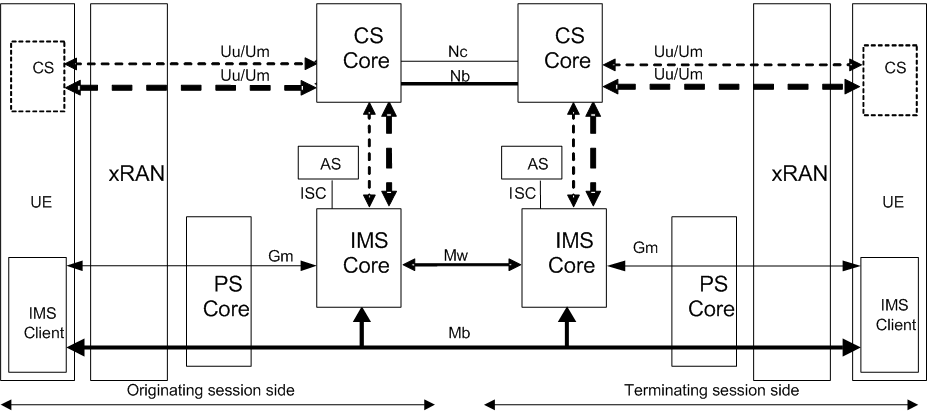Content for TS 23.279 Word version: 18.0.0
6 Architecture
6.1 General Architecture
6.2 CSI Application Server (CSI AS)
6.2.1 CSI AS functionality
6.2.2 Initial Filter Criteria
...
...
6 Architecture p. 11
6.1 General Architecture p. 11
The Figure below shows a high level E2E architecture of a simultaneous IMS session and CS call between two end-users belonging to the same operator.

- UE The UE needs to support simultaneous CS and PS domain access i.e. GERAN DTM and/or UTRAN multiRAB capabilities. Additionally, the UE should support the capability exchange mechanism outlined in clause 7, and the capability to present the CS call and IMS session within the same context to the user.
- xRAN The Radio Access Network is not impacted by Combinational Services. However, for CSI to function, for GERAN access DTM is required, for UTRAN multiRAB is required
- PS Core The Packet Switched Core network remains unchanged.
- CS Core The CS Core Network remains unchanged. The CS core network contains MSC/VLR, HLR, and possibly other logical elements according to the 3GPP specifications TS 23.002, TS 24.008 and TS 29.002. However for the Current Radio Environment information exchange to work, support for User-User Signalling Service 1 is required (TS 22.087).
- IMS Core The IMS routes the SIP signalling between the UE (A) and UE (B). In addition, the IMS provides the session control and supports UE capability exchange mechanism for the support of CSI. The IMS core includes the HSS, the CSCFs, and other logical elements like MRFC, MRFP, MGCF, or Messaging AS, according to 3GPP specifications TS 23.228.
- AS The means of using an AS is identical to its usage in IMS. The AS may be utilised to handle the control of the IMS specific aspects of a CSI session, for example service-based charging, as described in TS 22.115. If service-based charging mechanisms like charging based on the content of a multimedia message, the message type or the number of sent and/or received messages are required, then the AS should be involved. The AS may also provide support for time- and/or volume based charging, see TS 23.228 for a more detailed description. For meeting the requirements of interworking between UEs that use IMS origination and UEs that use CSI termination, the AS will implement the role of a CSI AS as specified in clause 6.2.
6.2 CSI Application Server (CSI AS) p. 12
6.2.1 CSI AS functionality p. 12
The CSI AS is an optional application server functionality in the IMS terminating network that serves as a control entity for enabling multimedia sessions between UEs that use IMS origination and UEs that use CSI termination. This functionality can be co-hosted within a standalone or any existing application servers. The main functionality of the CSI AS is:
- to retrieve the CSI related capabilities of UEs which have CSI capability, via third-party registration when the UE registers to IMS;
- to control the CSI termination by implementing a third-party call control logic (as per clause 4.2.4 of TS 23.228);
- to perform termination logic, i.e. examine the media components of a multimedia IMS session targeted toward a CSI capable UE and make a decision how to terminate them;
- to map a SIP URI to an associated Tel URI, in case the CSI AS decides to terminate an IMS session or part of the IMS session to the CS domain, and the CSI AS received a SIP URI of the called CSI capable user;
- to decide whether to keep itself in the session path or not;
- to handle session separation/forwarding for session initiation request, session modification request and session termination request.
- for CSI termination, to generate CSI capability information on behalf of the originating IMS UE and send it to the terminating CSI UE.
- SIP Caller preferences, Communication Service Identifiers or lack thereof;
- SDP Media components;
- UE capabilities.
6.2.2 Initial Filter Criteria p. 12
Initial filter criteria may be installed on a user's service profile regardless of their subscription so that applicable SIP requests are forwarded to the CSI AS in the terminating IMS network, and IMS registrations from a CSI capable UE are forwarded as third-party registrations to the CSI AS.
Trigger Points in the initial filter criteria may use the following criteria:
- IMS Communication Service ID, or lack of IMS Communication Service ID;
- The UE capability of CS voice and/or video capability during IMS registrations.